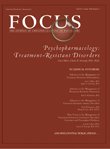Advances in the Management of Treatment- Resistant Schizophrenia
Abstract
Schizophrenia is a serious mental illness responsible for tremendous morbidity and decreases in quality of life and productivity. It is the eighth leading cause of disability-associated life years lost (1) and accounts for nearly 1.1% of overall losses according to the World Health Organization (2). Although there are several treatments for schizophrenia, numerous individuals continue to experience the wide range of symptoms with which many patients present. Current medications target positive symptoms, i.e., hallucinations and delusions, but are not effective for negative symptoms, i.e., apathy, social dysfunction, and flat affect, or cognitive symptoms, such as deficits in executive function and working memory.



